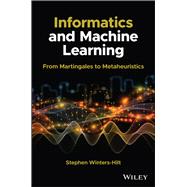Discover a thorough exploration of how to use computational, algorithmic, statistical, and informatics methods to analyze digital data
Informatics and Machine Learning: From Martingales to Metaheuristics delivers an interdisciplinary presentation on how analyze any data captured in digital form. The book describes how readers can conduct analyses of text, general sequential data, experimental observations over time, stock market and econometric histories, or symbolic data, like genomes. It contains large amounts of sample code to demonstrate the concepts contained within and assist with various levels of project work.
The book offers a complete presentation of the mathematical underpinnings of a wide variety of forms of data analysis and provides extensive examples of programming implementations. It is based on two decades worth of the distinguished author’s teaching and industry experience.
- A thorough introduction to probabilistic reasoning and bioinformatics, including Python shell scripting to obtain data counts, frequencies, probabilities, and anomalous statistics, or use with Bayes’ rule
- An exploration of information entropy and statistical measures, including Shannon entropy, relative entropy, maximum entropy (maxent), and mutual information
- A practical discussion of ad hoc, ab initio, and bootstrap signal acquisition methods, with examples from genome analytics and signal analytics
Perfect for undergraduate and graduate students in machine learning and data analytics programs, Informatics and Machine Learning: From Martingales to Metaheuristics will also earn a place in the libraries of mathematicians, engineers, computer scientists, and life scientists with an interest in those subjects.









